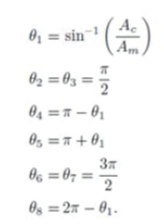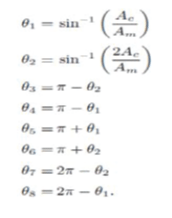ISSN ONLINE(2278-8875) PRINT (2320-3765)
ISSN ONLINE(2278-8875) PRINT (2320-3765)
| R. CharletPriya PG scholar, Department of Electricals and Electronics Engineering, Velammal Engineering college, Anna University, Chennai, India |
| Related article at Pubmed, Scholar Google |
Visit for more related articles at International Journal of Advanced Research in Electrical, Electronics and Instrumentation Engineering
This paper proposes a Variable Frequency Drive (VFD) Induction Motor using Seven-Level inverter in Air Conditioner for power reduction. In Air-conditioner we have high in-rush current which makes it to consume high power while running. The use of VFD in Induction motor facilitate in consuming constant current which produces constant power consumption. The use of Seven-level inverter helps in producing pure sine-wave through PWM which increases the performance.
Keywords |
||||||||||||||||
| Variable Frequency Drive (VFD), Seven- level inverter, Pulse Width Modulation(PWM). | ||||||||||||||||
INTRODUCTION |
||||||||||||||||
| Air Conditioning systems are typically the largest consumers of electrical energy in homes and office buildings. The number of home with air conditioning has been steadily rising over the past years and now more than 75%-85% of Indian households have either used window or room air conditioning systems[1]. The consumption of electricity by air conditioner is higher over years. | ||||||||||||||||
| This increase in consumption is due to the high in-rush current during the start of the compressor motor (i.e.) induction motor. The starting in-rush current of the motor can be reduced by VFD starting method which provides maximum control over the starting characteristics.Here Seven-level inverters are used to produce pure sinusoidal voltage waveform to the induction motors[5]. This multi-level inverter gives output current with better harmonic profile, less switching loss, cheap, lighter and compact[2].This paper thus describes a new control architecture for Air conditioning system that reduces the starting inrush current , optimizes the power reduction and also improves the efficiency of the motor. | ||||||||||||||||
| The industries today has begun to demand higher power equipment, which now reaches the megawatt level. Controlled ac drives in the megawatt range are usually connected to the medium-voltage network. Today, it is hard to connect a single power semiconductor switch directly to mediumvoltage grids (2.3, 3.3, 4.16, or 6.9 kV). Special attention is dedicated to the latest and more relevant applications of these converters such as laminators, conveyor belts, and unified power-flow controllers. | ||||||||||||||||
H-BRIDGE INVERTER |
||||||||||||||||
| A full-bridge single-phase inverter is known as an H-bridge inverter, which is illustrated in Figure 1. The full bridge inverter can provide either Bipolar or Uni-polar output voltage switching. | ||||||||||||||||
| The Uni-polar inverter is optimum for harmonic elimination more than the Bipolar inverter. Therefore the Uni-polar scheme is the optimum technique [3].The Uni-polar inverter circuit consists of four main switches and four freewheeling diodes. According to four-switch combination, three output voltage levels, +E, -E, and 0, can be synthesized for the voltage across a and b [4]. | ||||||||||||||||
PROPOSED INVERTER |
||||||||||||||||
| The proposed single-phase seven-level inverter was developed from the five-level inverter called the Modified HBridge inverter.It consists of a single-phase conventional H- bridge inverter, two bidirectional switches, and a capacitor voltage divider formed by C1, C2, and C3, as shown in Fig. 2. | ||||||||||||||||
| Here three reference signals that are identical with each other and a triangular carrier signal were used to generate PWM signals as shown in Fig 3.Proper switching of the inverter can produce seven output-voltage levels,[5](Vdc, 2Vdc/3, Vdc/3,0,−Vdc,−2Vdc/3,−Vdc/3) from the dc supply voltage. The proposed inverter’s operation can be divided into seven switching states, | ||||||||||||||||
| 1) Maximum positive output (Vdc) | ||||||||||||||||
| 2) Two-third positive output (2Vdc/3) | ||||||||||||||||
| 3) One-third positive output (Vdc/3) | ||||||||||||||||
| 4) Zero output | ||||||||||||||||
| 5) One-third negative output (−Vdc/3) | ||||||||||||||||
| 6) Two-third negative output (−2Vdc/3) | ||||||||||||||||
| 7) Maximum negative output (−Vdc) | ||||||||||||||||
PWM MODULATION |
||||||||||||||||
| A novel PWM modulation technique was introduced to Generate the PWM switching signals. Three reference signals (Vref1, Vref2, and Vref3) were compared with a carrier signal (Vc). The reference signals has same frequency and amplitude[4]. Fig. 3 shows the resulting switching pattern. Switches S1, S3, S5, and S6 would be switching at the rate of the carrier signal frequency, whereas S2 and S4 would operate at a frequency that was equivalent to the fundamental frequency. | ||||||||||||||||
| The six modes are described as follows: | ||||||||||||||||
| ïÃâ÷ Mode 1 : 0 <ωt< θ1 and θ4 <ωt< π | ||||||||||||||||
| ïÃâ÷ Mode 2 : θ1 <ωt< θ2 and θ3 <ωt< θ4 | ||||||||||||||||
| ïÃâ÷ Mode 3 : θ2 <ωt< θ3 | ||||||||||||||||
| ïÃâ÷ Mode 4 : π <ωt< θ5 and θ8 <ωt< 2π | ||||||||||||||||
| ïÃâ÷ Mode 5 : θ5 <ωt< θ6 and θ7 <ωt< θ8 | ||||||||||||||||
| ïÃâ÷ Mode 6 : θ6 <ωt< θ7.[6] | ||||||||||||||||
| when the modulation index is more than 0.33 and less than 0.66, the phase angle displacement is determined by, | ||||||||||||||||
 |
||||||||||||||||
| Here on calculating the THD value, it is lower when compared to other level inverters THD values. | ||||||||||||||||
| If the modulation index is more than 0.66, the phase angle displacement is determined by, | ||||||||||||||||
 |
||||||||||||||||
CIRCUIT DESCRIPTION |
||||||||||||||||
| The proposed circuit is as shown in Fig 4. It consists of 230V ac supply which is given to the rectifier circuit. The rectifier circuit converts ac into dc. This regulated dc voltage is given to the seven level inverter which produces pure sine wave and it is given to the induction motor. | ||||||||||||||||
| The microcontroller is used to produce the PWM sequences with references to the temperature given. In turn the PWM sequences only control the output of the phase controlled rectifier and Seven- level inverter. Gate driver circuit is used to efficiently drive the switches in the phase controlled rectifier and Seven-level inverter. LCD is used to display the current and set temperature. | ||||||||||||||||
| SIMULATION RESULTS | ||||||||||||||||
| PROTEUS SIMULINK software has been used for showing simulation result of the proposed configuration before it was physically implemented in a prototype. The PWM switching patterns were generated by comparing three reference signals (Vref1, Vref2, and Vref3) against a triangular carrier signal. These switching patterns with software simulation is as shown in Fig 5. | ||||||||||||||||
| Similar patterns are found for switch 5 and switch 6. | ||||||||||||||||
| Inverter output is been simulated separately and is shown in the Fig 6. | ||||||||||||||||
| THD value is calculated for the following inverter is 3.9% which is shown in Fig.7. | ||||||||||||||||
| Performance of the motor is also done in simulation and found to be 80%. This is shown in Fig 8. | ||||||||||||||||
CONCLUSION |
||||||||||||||||
| In this paper, a new application of Variable Frequency Drive in Induction Motor using Seven-level Inverter is used to reduce power consumed by Air-conditioner and also increases efficiency of the motor.The use of seven-level inverter topology here gives more advantageous over other topologies i.e. i.e., less power switch, power diodes, and less capacitors for inverters of the same number of levels. The simulation results shows that using this technique will have wide range of speed control whichin-turn controls the temperature of Air-conditioner. | ||||||||||||||||
Tables at a glance |
||||||||||||||||
|
||||||||||||||||
Figures at a glance |
||||||||||||||||
|
||||||||||||||||
References |
||||||||||||||||
|